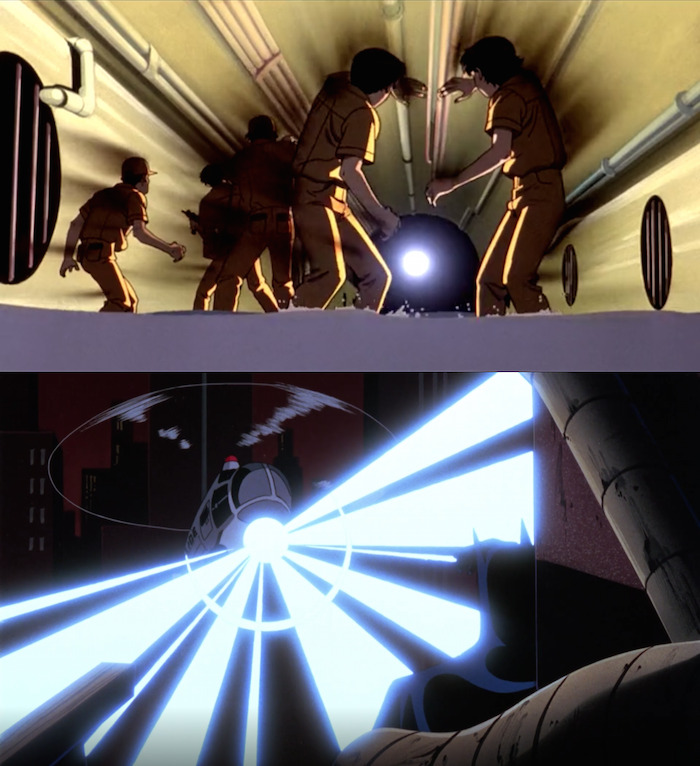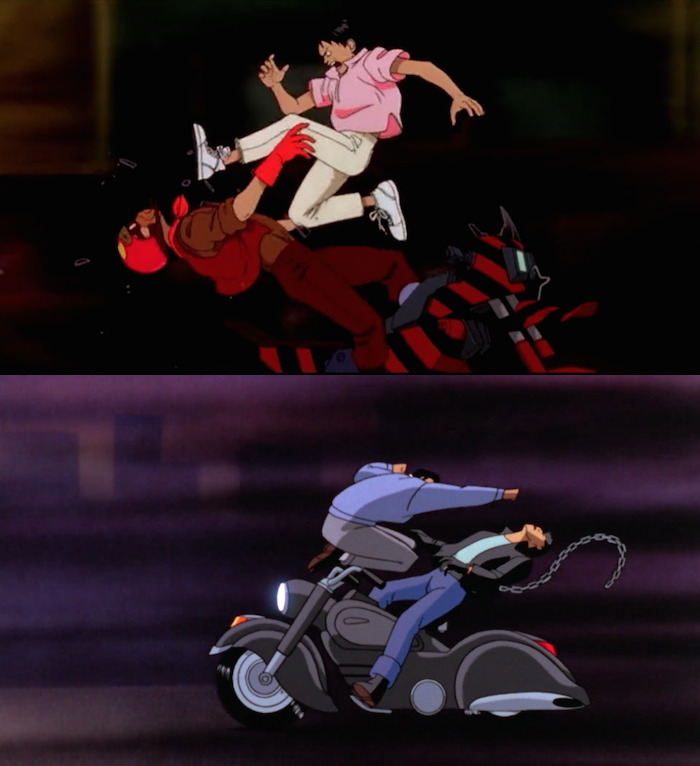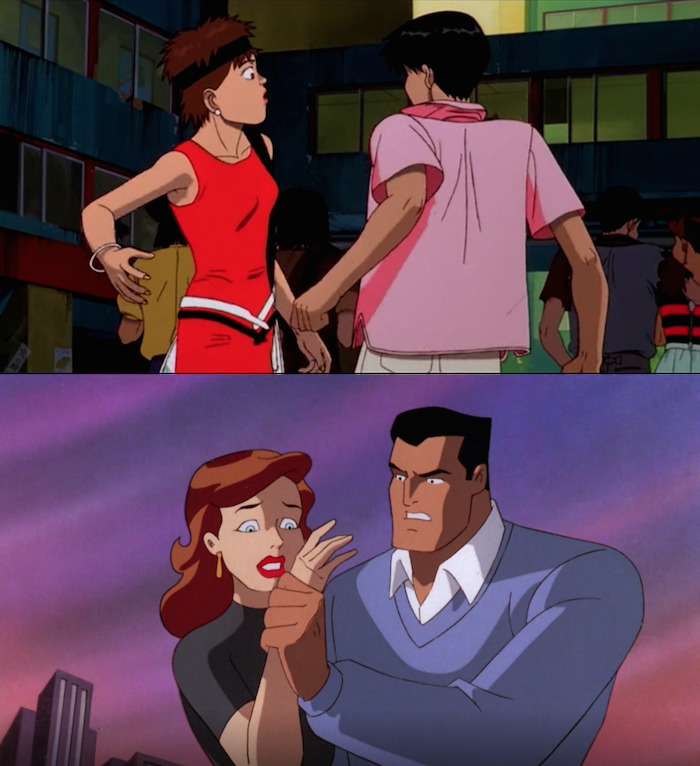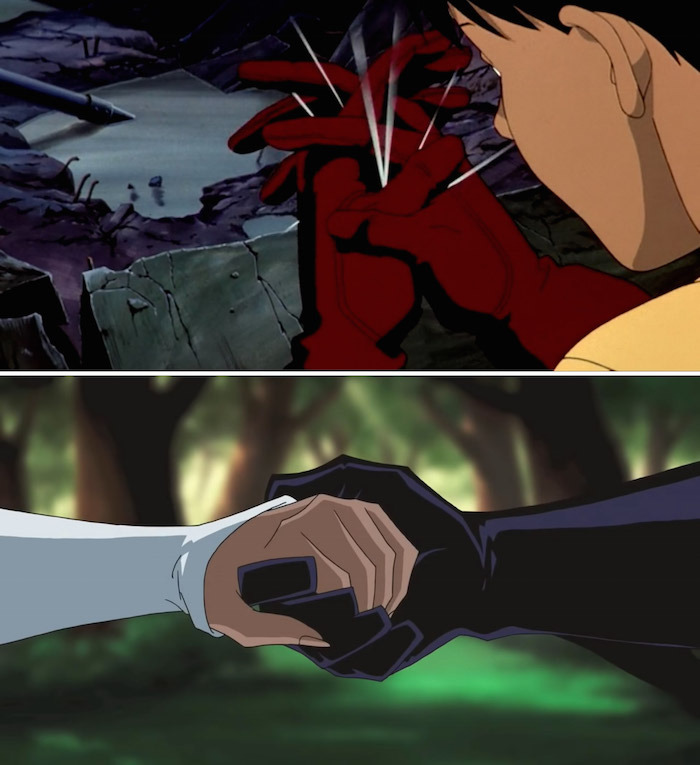How 'Batman: The Animated Series' And 'Akira' Are Forever Connected
This article contains spoilers for Akira and the Batman-centric DCAU films and TV shows.A giant explosion of light and sound. Biker gangs and crime-ridden streets. A city run by crooked politicians and a militarized police force. A flawed hero who operates outside the law and is pitted against a villain who thrives on chaos. All these make Batman: Mask of the Phantasm, the spinoff film of Batman: The Animated Series, one of the most iconic representations of the DC Comics hero ever put to a screen, but they're also major parts of what make the legendary anime film Akira tick, too.Both films celebrated big anniversaries last year — Phantasm turned 25 on December 25, and Akira crested its 30th birthday on July 16 — and they're both still widely respected as classics of their respective art forms. It's not an exaggeration to say Katsuhiro Otomo, creator of the Akira manga and director of the film, influenced a generation of artists around the world, and you can say the same for the film's version of Batman created by Bruce Timm, Eric Radomski, and Alan Burnett.What's harder to pin down is what the two iconic movies have in common. While they couldn't be more different plotwise, both films share a lot of DNA that showed up not just Phantasm's source TV series Batman: The Animated Series, but the rest of the DC Animated Universe properties for years to come. There's clear homage to Akira, yes, but over the years the B:TAS spinoff properties have also borrowed its animators and — most importantly — ideas that enrich how we understand the character today.
On the surface, the movies have little to do with each other
To get the obvious out of the way, the plots and settings of Phantasm and Akira couldn't be more different. The former is a superhero noir romance and murder-mystery starring DC's Caped Crusader, and the latter is a science-fiction adaptation of a Japanese manga about a biker gang of punk kids discovering godly psychic power in post-apocalyptic Tokyo.Their action-packed narratives both pit those characters against systemic (government, cops) and chaotic (Akira, Joker) obstacles, but they're fundamentally distinct stories that land on different, though not necessarily exclusive, conclusions about the human condition. Akira's ending is open to interpretation but alludes to a main character achieving some form of godhood, while Phantasm is clear cut and less optimistic: Batman solves the mystery and beats the bad guys, but he doesn't get the girl. No fan of either movie would argue that it's that simple, but those are the basics. Still, the Phantasm team clearly fed off of the visuals and themes of Akira to serve their own story, as well as subsequent Batman stories for years to come.
The obvious visual homage to Akira in Phantasm is also a thematic one
There's no question when you watch the clips side by side. Phantasm features a flashback scene where a young Bruce Wayne (still not graduated into Batman yet) fights off a gang of criminals on the street while he's out on the town with his lady friend, Andrea Beaumont. Bruce takes out one of the goons on a motorcycle, and the framing mimics the way Akira's hero Kaneda takes out a rival biker in that film. Bruce punches and Kaneda kicks, but the shots are otherwise the same: protagonist runs toward bike on foot, cut to biker, cut back to protagonist's foot stepping on the bike's front fender and connecting to hit the biker in the face, cut to wider slow-motion shot of the hit, cut to the bike careening off to a crash.When presented with the clips side by side, a Warner Bros. representative told /Film that any similarities between Akira and Phantasm specifically were purely coincidental — citing instead The Godfather, the 1940s Fleischer Superman cartoons, and Tim Burton's Batman as the Phantasm producers' primary influences. Nonetheless, the similarities to Akira are clear, and they go deeper than aesthetics. In both scenes an angry male protagonist, accompanied by a young woman, intervenes in a situation that — at first — shouldn't involve him. Bruce's sense of justice can't stomach seeing a civilian robbed, and Kaneda's protectiveness for his friend Tetsuo drives him to act when he sees Tetsuo getting attacked by the rival bike gang. They're character-building moments early enough in their respective narratives that reinforce Bruce and Kaneda's toxic masculinity and their tendency to resort to what the theologian and cultural theorist Walter Wink would later call "the myth of redemptive violence" to solve problems.
For much of Phantasm and Akira, Wink's (arguably reductive) view of pop-culture heroes applies to both Batman and Kaneda: "An indestructible hero is doggedly opposed to an irreformable and equally indestructible villain." And that classification may be true for some heroes, but neither film leaves it at that. By the end of Akira, Kaneda has watched his friend turn into a monster thanks to bad luck and scientific malpractice and transcend the mortal plane. By the end of Phantasm, Batman is heartbroken that Andrea — his one chance at long-term happiness and a woman he had proposed to — has succumbed to the same forces that drove him to violence. The broad lesson in both is that violence and the human tendency toward hate beget more of the same.
But Akira's connection to Batman cuts way closer
The TAS episode "Robin's Reckoning"—which won an Emmy—has an arguably even more popular homage to Akira. If you've dived deep enough into the anime nerd fandom, odds are, you've seen some version of this GIF. It's from one of the iconic biker sequences of Akira, a shot where Kaneda slides his bike that's been mimicked or parodied countless times, from Batman: The Animated Series, to Pokemon to Adventure Time (twice), to art for The Legend of Zelda: Breath of the Wild. And again, character-wise the moment is similar in TAS. In that episode, it just happens to be Robin rather than Batman doling out the violence.None of this was an accident or even all that surprising if you know something about the credits on the series. As the show's first animation director, Kevin Altieri — who worked on Phantasm and who riffed on the work of Hayao Miyazaki in episodes he directed for B:TAS — recently said on Batman: The Animated Podcast: "I was a nut for Japanese animation back [in the early '90s]."Then there's the fact that the B:TAS team in the United States literally contracted Akira's animators to work on episodes of the show, as well as Phantasm. For outsourced animation, the Warner Bros. team turned to overseas animation studios in Japan such as TMS Entertainment and Spectrum Animation (which was staffed by former TMS employees) just a few years after TMS had brought Akira to life. The website World's Finest has reprinted the now-defunct magazine Animato!'s analysis of select episodes from the series, complete with dozens of quotes from TAS producers and directors like Bruce Timm, Eric Radomski, Alan Burnett, and more commenting on the overseas studios' work on the show.
The Batman team also hired an Akira animator for a specific scene of Batman Beyond...
One of those artists who worked on both Akira and the Batman properties produced by Warner Bros was Hiroyuki Aoyama, an animator who also worked on animating the orbital laser weapon in the latter half of Akira. The laser is a symbol of military might and a potent post-war image for Japan, and in the film, it's used to strike against Japan itself as the military seeks to control Tetsuo's psychic powers. The gauntlet of destructive force that follows is one of Akira's most harrowing scenes, full of flesh melting off bone, concrete erupting from the earth, and the film's heroes fleeing for their lives.So obviously the Warner Bros. team took inspiration from that as it was developing the 2000 movie Batman Beyond: Return of the Joker. The show Batman Beyond had already taken cues from Akira, as it was set in a borderline-dystopian Gotham of the future, complete with its own young biker gangs, sweeping lit-up cityscapes, and a younger and rougher kid named Terry McGinnis as Batman. The creative team of director Curt Geda and producers Timm, Burnett, Paul Dini, and Glen Murakami took that influence a step beyond for the show's movie, just as they had with Phantasm. In Return of the Joker, Batman's arch-nemesis comes back after years presumed dead. In his climactic joke, he hijacks a giant military space laser to threaten the planet.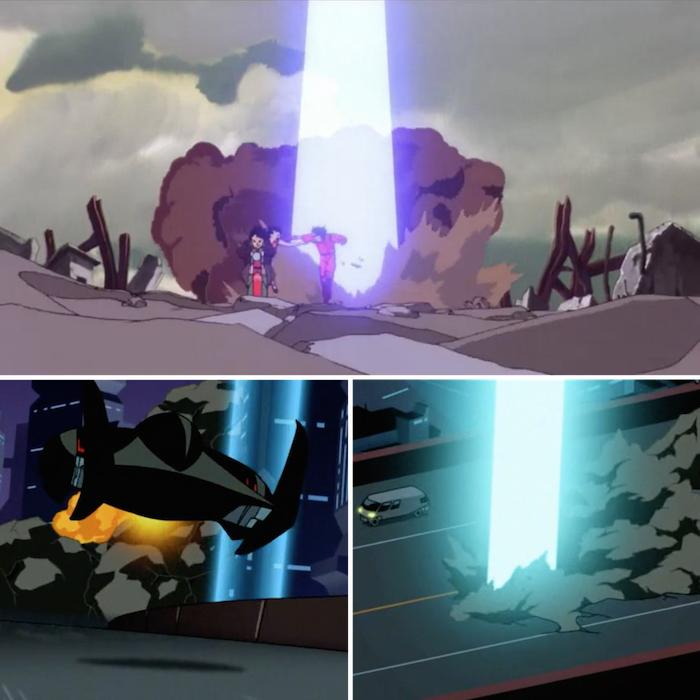 In fact, the Warner Bros. team actually got Aoyama — who had also served as an animator the B:TAS episode "Feat of Clay" — to lead the animation of the orbital laser weapon sequence in Return of the Joker. "He found this to be a challenge, 15 years later, to see if he could top what he had done in Akira," Timm explained on Return of the Joker's commentary track. "It's not for me to say whether he did or not, but he sure did a great job of destroying this city." His efforts paid off. The resulting final sequence is a masterwork of detail, depth, and motion, filled in with minor touches of artistry that the producer admitted on the commentary that his team didn't even specify in notes to Aoyama.The effect of contracting the labor of artists like Aoyama and others at TMS goes beyond homage or just making this targeted obliteration look good on film (though it undoubtedly does). It subtly centralizes and reifies Akira's themes again for American audiences. There is power in advancing the idea that a military can raze a city of civilians with death from above, and that their control over such a power could be undermined by desperate individuals or bad actors, which happens in both films. There is power in advancing the idea that systemic inequality in a patriarchal society can lead to violence committed by and in inflicted on young boys and perpetuated by ever-more-violent men — potentially destroying their lives or eroding their sense of self. There is power in acknowledging that original art was created by artists animating from a specific perspective shaded by the effect of Western imperialism. And there is power in allowing them to translate their art into a new form. All this is true whether Timm or his collaborators thought about it or not when they contracted Aoyama or his collaborators from TMS, Spectrum, or other animation houses.And one response to this is to disregard it entirely, right? To say, Screw it, it's just Batman and the action looks cool and he kicks ass. Or worse, to say, Screw it, it's just a cartoon and it doesn't matter. Both those interpretations would reduce these animated works of art exactly to what Wink criticized them as: empty pop culture with no moral center, made by cynics as an opiate for literal babies.
In fact, the Warner Bros. team actually got Aoyama — who had also served as an animator the B:TAS episode "Feat of Clay" — to lead the animation of the orbital laser weapon sequence in Return of the Joker. "He found this to be a challenge, 15 years later, to see if he could top what he had done in Akira," Timm explained on Return of the Joker's commentary track. "It's not for me to say whether he did or not, but he sure did a great job of destroying this city." His efforts paid off. The resulting final sequence is a masterwork of detail, depth, and motion, filled in with minor touches of artistry that the producer admitted on the commentary that his team didn't even specify in notes to Aoyama.The effect of contracting the labor of artists like Aoyama and others at TMS goes beyond homage or just making this targeted obliteration look good on film (though it undoubtedly does). It subtly centralizes and reifies Akira's themes again for American audiences. There is power in advancing the idea that a military can raze a city of civilians with death from above, and that their control over such a power could be undermined by desperate individuals or bad actors, which happens in both films. There is power in advancing the idea that systemic inequality in a patriarchal society can lead to violence committed by and in inflicted on young boys and perpetuated by ever-more-violent men — potentially destroying their lives or eroding their sense of self. There is power in acknowledging that original art was created by artists animating from a specific perspective shaded by the effect of Western imperialism. And there is power in allowing them to translate their art into a new form. All this is true whether Timm or his collaborators thought about it or not when they contracted Aoyama or his collaborators from TMS, Spectrum, or other animation houses.And one response to this is to disregard it entirely, right? To say, Screw it, it's just Batman and the action looks cool and he kicks ass. Or worse, to say, Screw it, it's just a cartoon and it doesn't matter. Both those interpretations would reduce these animated works of art exactly to what Wink criticized them as: empty pop culture with no moral center, made by cynics as an opiate for literal babies.
And the influence echoed right up until the end of the DCAU
But if you actually watch enough of the shows in the DCAU and actually paid attention to Akira, the cynical reading just doesn't hold water. In 2005, the same creative team released the Justice League: Unlimited episode, "Epilogue," which served as a coda not just to Timm and Co.'s animated Batman, but to the continuity they'd established over the last decade-plus of superhero storytelling. It's an episode that knits the threads of B:TAS, Phantasm (with a fun cameo from Andrea Beaumont), Justice League: Unlimited, and Batman Beyond together, but its most powerful scene features yet another obvious echo of Akira, too.It's a flashback, and Batman (back to Bruce Wayne this time) has to confront a young girl named Ace with increasingly unstable psychic powers and end her life. At first Ace's powers only warped people's perception, just like Tetsuo's in early scenes of Akira, but as they grow more powerful, they begin to warp reality itself with a potential destructive force that could wipe out entire cities. Batman's job is to kill her before that happens, which he agrees to do, racing into the danger alone just as Kaneda did. When the time comes, though, he throws his weapon away and admits he had no intention of ending her life. Instead Batman sits with Ace and holds her hand, comforting her as her own mind crashes in on her, ending her life. (If this weren't sad enough, an older Bruce Wayne in the same continuity goes on to name his trusted dog "Ace" in Batman Beyond.)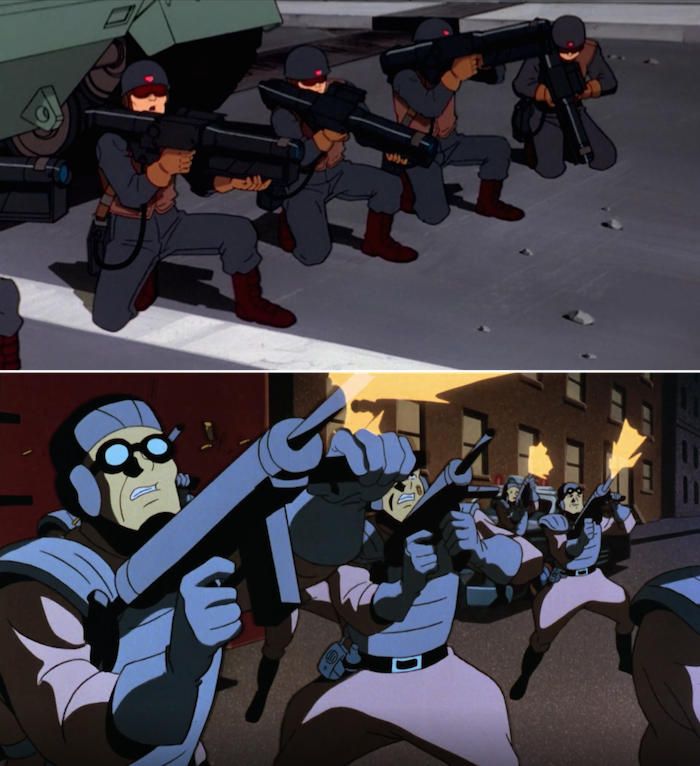 Violence isn't redemptive in Akira, and it's not redemptive in Phantasm, Batman Beyond, or "Epilogue." No one is better off thanks to violence — not the agents of violence and certainly not its victims — by the end of those stories. What does leave them better off is love. One of Akira's most indelible images is that of Kaneda kneeling and holding Tetsuo's final essence in his hands, as if in prayer, before Tetsuo transcends to another plane. Phantasm ends with Bruce Wayne holding the locket that symbolized his lost love, and the flashback in "Epilogue" ends with him holding Ace's dead body in his arms. The point is that these heroes are not as "indestructible" as Wink would prefer and that their most compelling conflicts are not with a lame villain, but with the psychological forces that interfere with their heroism. The heroes redeem themselves with the choices they make to overcome those psychological forces."Epilogue" hammers this home in its teleplay, written by Dwayne McDuffie. Echoing Phantasm, the Batman of the future, McGinnis, engagement ring in hand, has the notion of proposing to his longtime girlfriend but is conflicted as to what that could mean for his alter-ego. And Amanda Waller, the government agent who originally conscripted Batman to kill Ace, gives him this advice: "You want to have a little better life than the old man? Take care of the people who love you. Or don't. It's your choice."In the end, this new Batman, learning from the mistakes of the old Batman, makes the right choice.
Violence isn't redemptive in Akira, and it's not redemptive in Phantasm, Batman Beyond, or "Epilogue." No one is better off thanks to violence — not the agents of violence and certainly not its victims — by the end of those stories. What does leave them better off is love. One of Akira's most indelible images is that of Kaneda kneeling and holding Tetsuo's final essence in his hands, as if in prayer, before Tetsuo transcends to another plane. Phantasm ends with Bruce Wayne holding the locket that symbolized his lost love, and the flashback in "Epilogue" ends with him holding Ace's dead body in his arms. The point is that these heroes are not as "indestructible" as Wink would prefer and that their most compelling conflicts are not with a lame villain, but with the psychological forces that interfere with their heroism. The heroes redeem themselves with the choices they make to overcome those psychological forces."Epilogue" hammers this home in its teleplay, written by Dwayne McDuffie. Echoing Phantasm, the Batman of the future, McGinnis, engagement ring in hand, has the notion of proposing to his longtime girlfriend but is conflicted as to what that could mean for his alter-ego. And Amanda Waller, the government agent who originally conscripted Batman to kill Ace, gives him this advice: "You want to have a little better life than the old man? Take care of the people who love you. Or don't. It's your choice."In the end, this new Batman, learning from the mistakes of the old Batman, makes the right choice.

